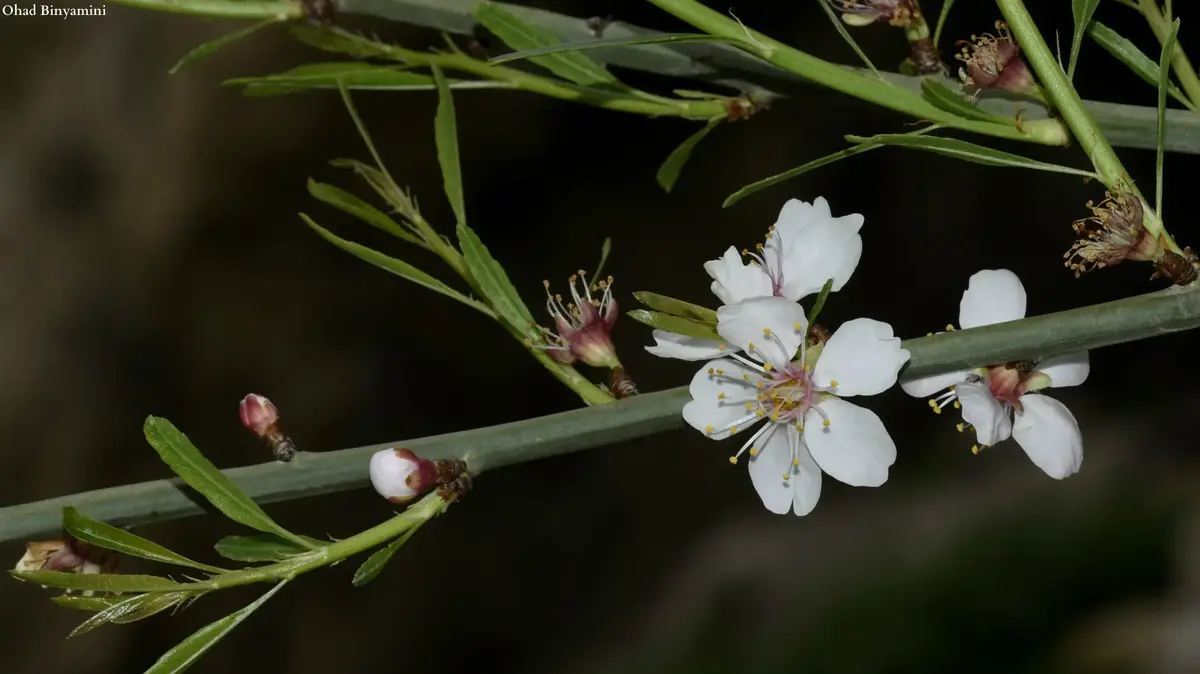Shakdia, Ein Kerem National Park, 11.1.23/Photo: Walla!
A Rotem-like shrub that is considered extremely rare.
Shaked Arabi/The Society for the Protection of Nature, Ohad Binyamini
Three individuals of
the Arabic almond
(Amygdalus Arabica), a Rotem-like shrub considered extremely rare, of which only one individual is known to have survived in the wild, were found by a hiker in the Binyamin region.
About two weeks ago, Eran Sapir, a boy from the settlement of Ma'ale Machmash in the Givat Binyamin area, was walking in one of the wadis of the Machhash stream called "Wadi Habibi", known for its rare vegetation.
Sapir, an avid nature lover who is expected to join the Sde Afra School of the Society for the Protection of Nature as a guide for a year of service, was looking for cliff vegetation but did not imagine that he would find the Arabian almond.
More on the subject:
Save for a beautiful day: Routes following the almond tree that is already in bloom
Almond blossoms: come for a picnic in the largest and most blooming orchard in Israel
Tu Beshavt trip: Where will you see almond blossoms in Israel?
The Arab almond tree is characterized by thin, green branches that are leafless for most of the year/Society for the Protection of Nature, Ohad Binyamini
Eran Sapir in search of the Arabian almond in Nahal Mechmash/The Society for the Protection of Nature, courtesy of the photographer
The area where the details of the rare Arabian almond were discovered / Society for the Protection of Nature, Amit Mendelson
"I returned to the river with my father and brother, and we found another detail in the bloom"
"I got there before Shabbat with my father and I saw a Rotmi bush in the distance, which seemed very different to me, but due to the lack of time we decided to return on Shabbat, in the morning, so that I could get to school. We returned, and after a 20-minute search I found it in front of a flower. How long did I return to the stream with my father and brother, and we found another detail in bloom. On another tour of the area we found another detail that is now blooming. This is an extraordinary discovery, very rare and special of its kind," he says excitedly.
The Society for the Protection of Nature states that the genus Amygdalus has about 36 species of shrubs or small trees, which are distributed from Central Asia to Europe.
Almonds belong to the rose family, which includes many other edible trees such as pears, apples, strawberries, and more.
All wild species of almonds have a large, white seed that contains a large amount of a toxic and bitter substance called amygdalin, which is created in the almond seeds in order to prevent the large, rich seed from being eaten by animals.
Ohad Binyamini from the Society for the Protection of Nature, adds that the Arabian almond was first discovered in Israel in 1977 by Mimi Ron.
According to him, the Arabian almond belongs to a group of Rotem-like almonds, grown in the mountainous areas of the Middle East.
They are characterized by thin, green and leafless branches for most of the year, but when they bloom, these bushes are covered with small almond flowers and buttons.
"The Arabian almond is a tree of the mountains of Turkey and Iran, and there are also a few specimens in Jordan, also there extremely rare and on the verge of extinction. In the past there were several reports about Arabian almonds in the streams of Mizrah Binyamin, but in recent years only two specimens are known, which grow not far from each other In the Makhash River that flows into the Perat River. About two years ago, probably as a result of overgrazing in the area, one of the individuals died and a single individual remained, dangling from the cliffs of the Makhash River. Eran's discovery is very important and interesting, and I hope that the means will be found to preserve the limited population of the Arab almond in Israel, for the benefit of generations The following," he says.
The Arabian almond was discovered for the first time in Israel in 1977/The Society for the Protection of Nature, Ohad Binyamini
The Arabian almond was discovered in one of the wadis of Nahal Makhash called "Wadi Habibi" / Society for the Protection of Nature, Amit Mendelson
The genus Shaked includes about 36 species of shrubs or small trees, whose distribution is from Central Asia to Europe / Society for the Protection of Nature, Eran Sapir
What is the significance of the discovery ecologically?
According to Yair Eliav, director of the Sde Ofra school, the discovery requires tracking and monitoring the details, searching for more details in the immediate area and in general, and preserving the rare bushes.
"The Mechmesh River, one of the impressive tributaries of the Euphrates River, is home to rare plants, endangered winged birds such as the golden eagle and the hawk eagle, songbirds such as the mountain bowtie, the desert lark, the black-tailed godwit, the winter rock and the lone rock, and special wild animals such as fallow deer Israelis, hypocrites, and more. However, above it, there is a sewage treatment plant that flows sewage into the creek, endangering its unique ecosystem and that of the Euphrates. We are happy for the exciting find and are already looking forward to what is to come and hope that a solution will be found to the discharges of pollutants that endanger life there," he concludes .
More on the same topic:
almonds
trees
ore

